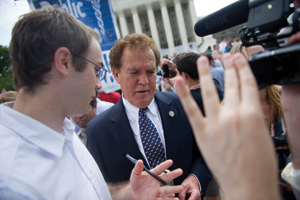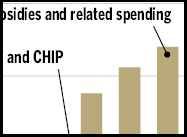CQ WEEKLY – IN FOCUS
Nov. 24, 2012 – 11:39 a.m.
A House of Cards in Deficit Talks
By Melissa Attias, CQ Staff
Talk of finding health care savings in the federal budget inevitably involves making changes to Medicare. But some lawmakers are starting to suggest that President

|
||
|
In its entirety, the law is expected to reduce the deficit over time, according to the Congressional Budget Office. At the same time, it contains individual provisions that, by themselves, cost money. Some observers, especially Republicans on the lookout for ways to constrain the 2010 law, say negotiators trying to avoid upcoming tax increases and spending cuts — known collectively as the fiscal cliff — should take a hard look at those provisions.
The problem is, the two most costly parts of the law — setting up subsidies to help people buy insurance and expanding Medicaid to provide care to more uninsured Americans — are also two of the pillars upon which the law is built. If lawmakers start scraping money away from either, they risk weakening the law.
Subsidies and related spending are estimated to boost the deficit by more than $1 trillion over 11 years, according to the CBO. An additional $642 billion spending increase is projected from Medicaid and the Children’s Health Insurance Program.
Rep.
But the subsidies and the Medicaid expansion “are so integral to the success of the law that it’s not possible to think about implementation without these reforms,” says Sara Rosenbaum, a health law and policy professor at George Washington University. That means chances are slim the White House or congressional Democrats would agree to put them on the chopping block as they try to protect one of Obama’s main achievements.
“I would think the president would want to maintain the health care law,” says
No matter what stand Democrats take, changes in the law can be expected to come up as negotiations continue in the lame-duck session and next year.
“I’ve been clear,’’ House Speaker
Targeting Subsidies

|
||
|
Of the law’s major spending elements, the one that might be most vulnerable to reductions is the subsidies that will be available beginning in 2014 for people who buy health insurance through marketplaces known as exchanges.
A House of Cards in Deficit Talks
Eligible individuals and families would receive assistance to help pay their health insurance premiums and reduce out-of-pocket costs for medical services. The amount of aid would vary based on income and, in many cases, extend to those earning up to 400 percent of the poverty line — $92,200 for a family of four in 2012.
Setting a lower subsidy level “would be one that could generate scorable savings quickly and, at the same time, is not hitting the vulnerable, low-income people out there,” says the Bipartisan Policy Center’s G. William Hoagland, who recently served as CIGNA’s vice president of public policy and before that was a top Senate GOP budget aide.
If negotiators seek savings in that area, they could reduce the amount of assistance or constrain eligibility for those with higher incomes. And since the subsidies aren’t yet available, lawmakers might feel less political pain in limiting them.
But there are reasons why Democrats would oppose that effort. Paul N. Van de Water, a senior fellow at the Center on Budget and Policy Priorities, says cutting back subsidies would be seen as undermining the law because supporters want to have as many people as possible participating in the exchanges. Others argue that the subsidies aren’t all that generous now, and reducing them would make health insurance even less affordable.
Cuts to Medicaid might be even less palatable since the Supreme Court effectively made it optional for states to participate in the program’s expansion. Van de Water says anything that shifts Medicaid spending to the states would create a disincentive for them to take part.
As the law stands, starting in 2014 states can extend their Medicaid programs to include individuals under age 65 with annual incomes of up to 133 percent of the poverty line with an enhanced federal match. The federal government would cover 100 percent of the costs of newly eligible participants from 2014 through 2016, with its share gradually decreasing to 90 percent in 2020 and thereafter.
That’s “unprecedented help” from the government because the average federal payment currently falls between 56 percent and 57 percent of program costs, says Families USA Executive Director Ron Pollack. But some states already have expressed concern that federal payments will be unreliable, and that makes any cuts risky for supporters of the law.
“The guarantee of federal funding to the states is really essential to get the states to opt into that expansion,” Pollack says.
Although it’s unlikely that Democrats would invite changes to the core of the overhaul, they have agreed to smaller-scale cuts in the past. The law’s preventive health fund was tapped in February, for example, to help offset legislation that extended a payroll tax break and prevented a Medicare payment cut for physicians.
But there isn’t much additional savings in pots like that one. The CBO has estimated that repealing what’s left of the fund would save $12 billion through fiscal 2022 — nowhere close to the amount that would come from cutting subsidies or additional money for Medicaid.
“There are not enough dogs and cats to herd together to get you where you need to be,” says Edmund F. Haislmaier, a senior research fellow at the Heritage Foundation.
Other Possible Savings
Hoagland says negotiators could look at speeding up the law’s timetable for some revenue-earning provisions, such as the “Cadillac tax” on high-cost insurance plans set to take effect in 2018. Lawmakers also might find savings by converting some pilot projects into permanent programs, he says, or changing reimbursement rates for Medicare Advantage.
A House of Cards in Deficit Talks
There’s also a question of whether provisions that have attracted bipartisan opposition might get wrapped into a larger spending deal. Republicans have forcefully challenged the Independent Payment Advisory Board, for example, which was created to make cost-cutting recommendations if Medicare spending exceeds target growth rates.
Abolishing the board would cost money — $3.1 billion over 10 years, according to a CBO estimate — but one health industry representative says he could imagine a situation in which Republicans push for repeal as a sweetener in a broader compromise. Because some Democrats also oppose the panel, they might go along even though Obama continues to support the board.
Another idea being tossed around is the possibility of delaying aspects of implementation in an effort to achieve short-term savings. There is already speculation that there might be too little time to set up the exchanges so that they’re ready for enrollment in October 2013. But despite the appeal of that approach for Republicans, Haislmaier says it would be “an exercise in kicking the can down the road.” The problem is that Congress would have to delay more than just the key spending pieces because the elements of the law are interconnected, he says.
Robert Laszewski, president of the consulting firm Health Policy and Strategy Associates, also argues that pushing back implementation would be a political liability for Democrats because 2014 — the year many integral provisions are scheduled to take effect — is an election year. For supporters of the law, he says, agreeing to a delay would be tantamount to conceding that everything Republicans have said about the law being unmanageable is true.
“I can’t think of a greater gift to Republicans . . . than Democrats admitting they can’t get it implemented,” Laszewski says.
Pollack also emphasizes Democrats’ incentive to get the law’s benefits in effect and make sure the overhaul is as stable as possible when Obama leaves the White House, so that the law is harder to reverse.
“If you have something like three years of implementation under your belt . . . then I think it is highly unlikely that any presidential candidate — Republican or Democrat — will want to raise repeal as a politically thoughtful thing to do,” he says.
John Reichard contributed to this story.
FOR FURTHER READING: Fiscal cliff, p. 2382; health care law (PL 111-148, PL 111-152), 2010 Almanac, p. 9-3.